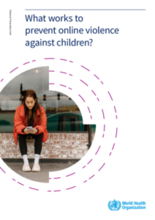This World Health Organization report, "What works to prevent online violence against children", presents ways to address the growing worldwide concern of keeping children safe online, with a specific focus on two forms of online violence: child sexual abuse including grooming and sexual image abuse; and cyber aggression and harassment in the form of cyberbullying, cyberstalking, hacking and identity theft. The report recommends implementing school-based educational programmes that have multiple sessions, promote interaction among youth and engage parents. It highlights the need for improvements in several areas including:
- the need for more violence prevention programmes that integrate content about online dangers with offline violence prevention, given the overlap of these problems and their common approaches to prevention;
- less emphasis on stranger danger as strangers are not the sole or even the predominant offenders in online violence against children;
- more emphasis on acquaintance and peer perpetrators, who are responsible for a majority of offenses; and
- more attention to healthy relationship skills, since romance and intimacy-seeking are major sources of vulnerability to online violence.

